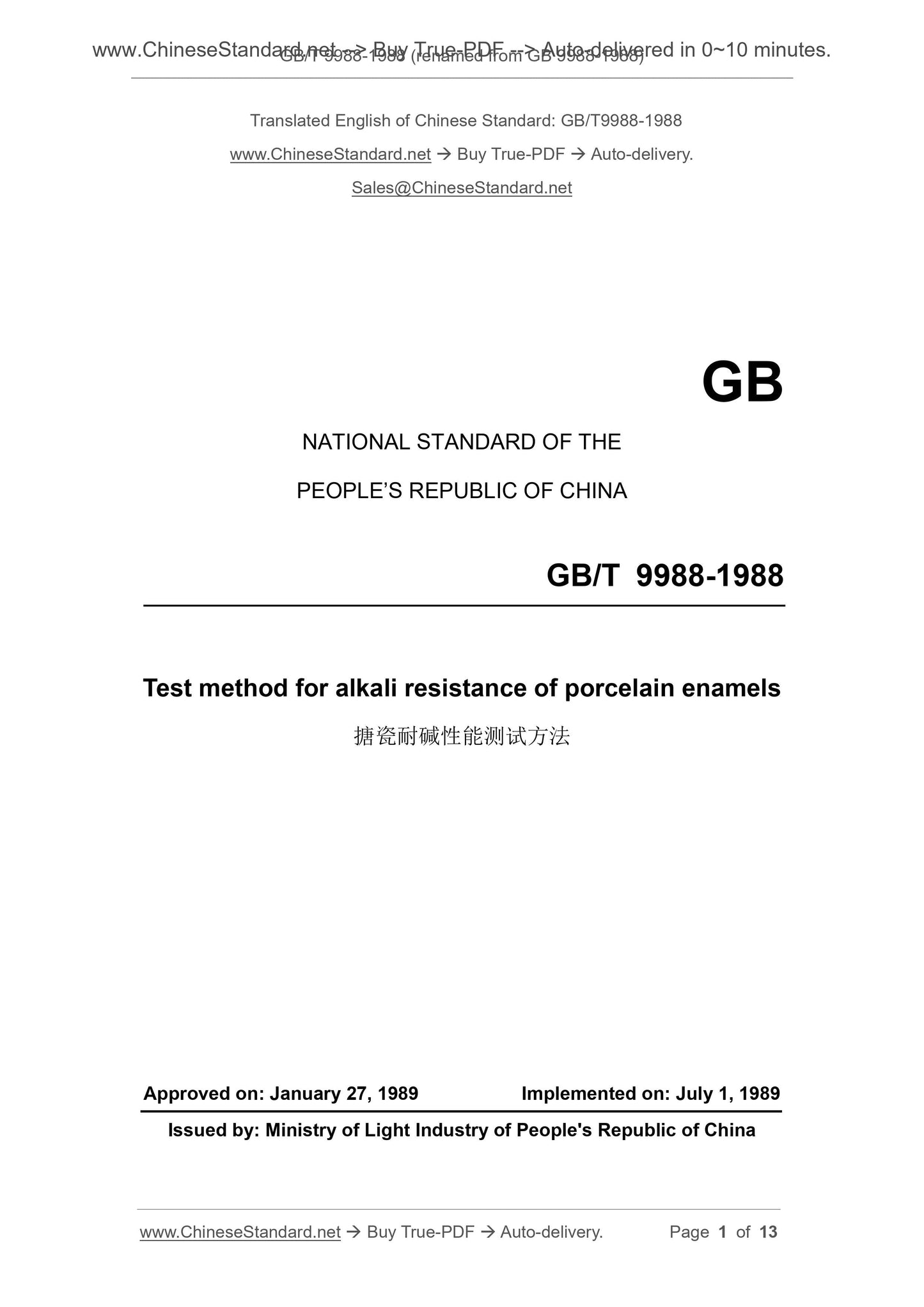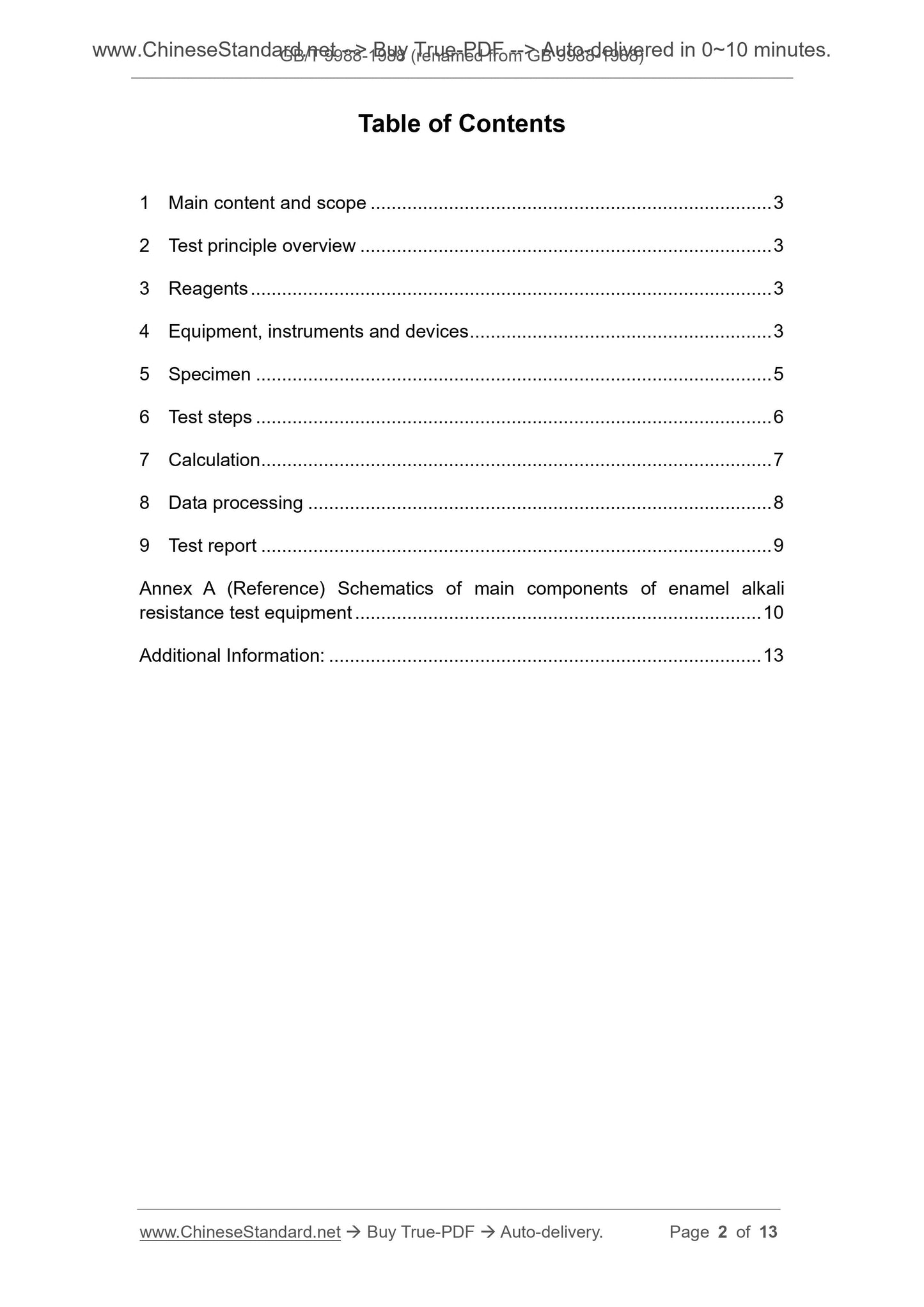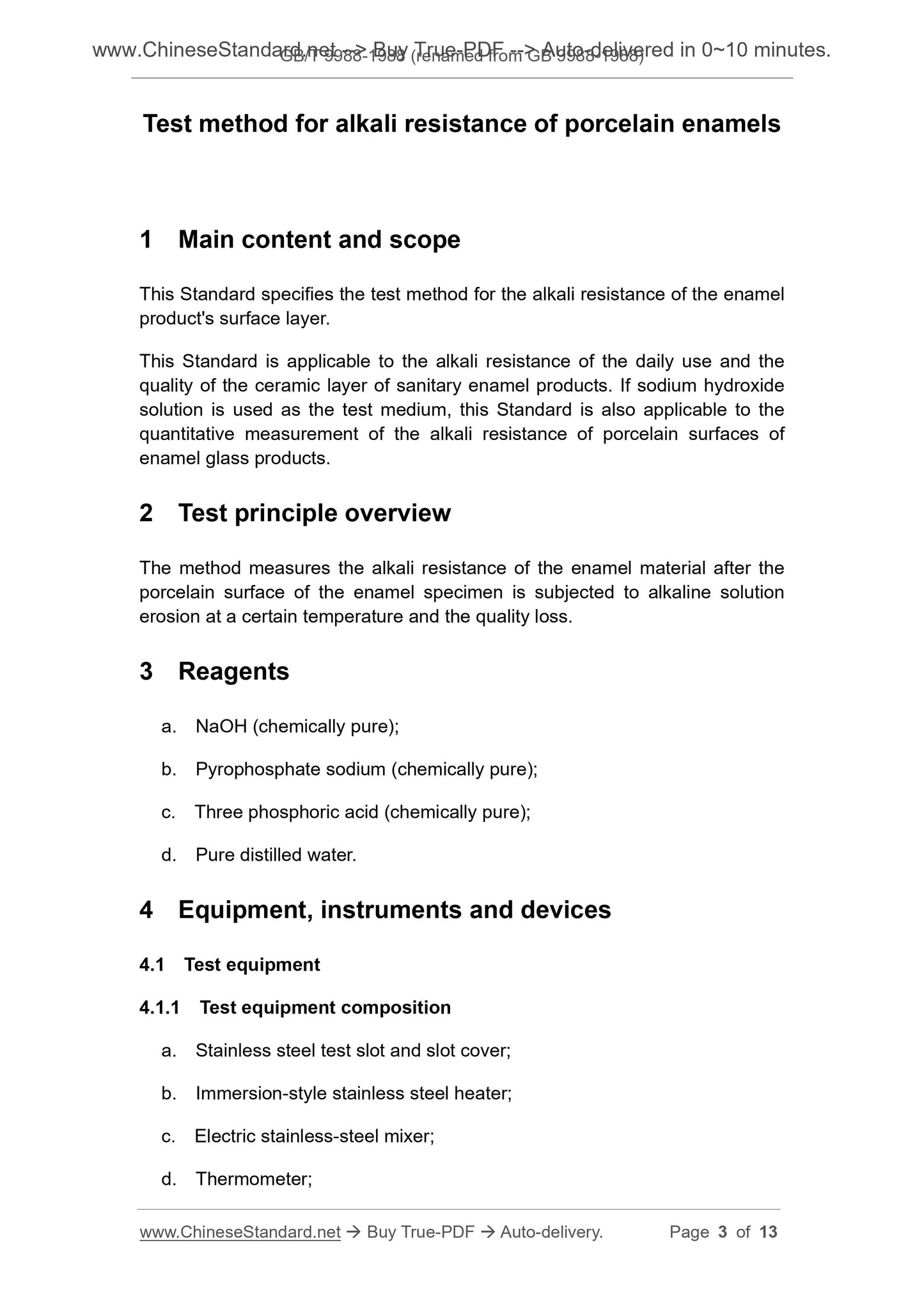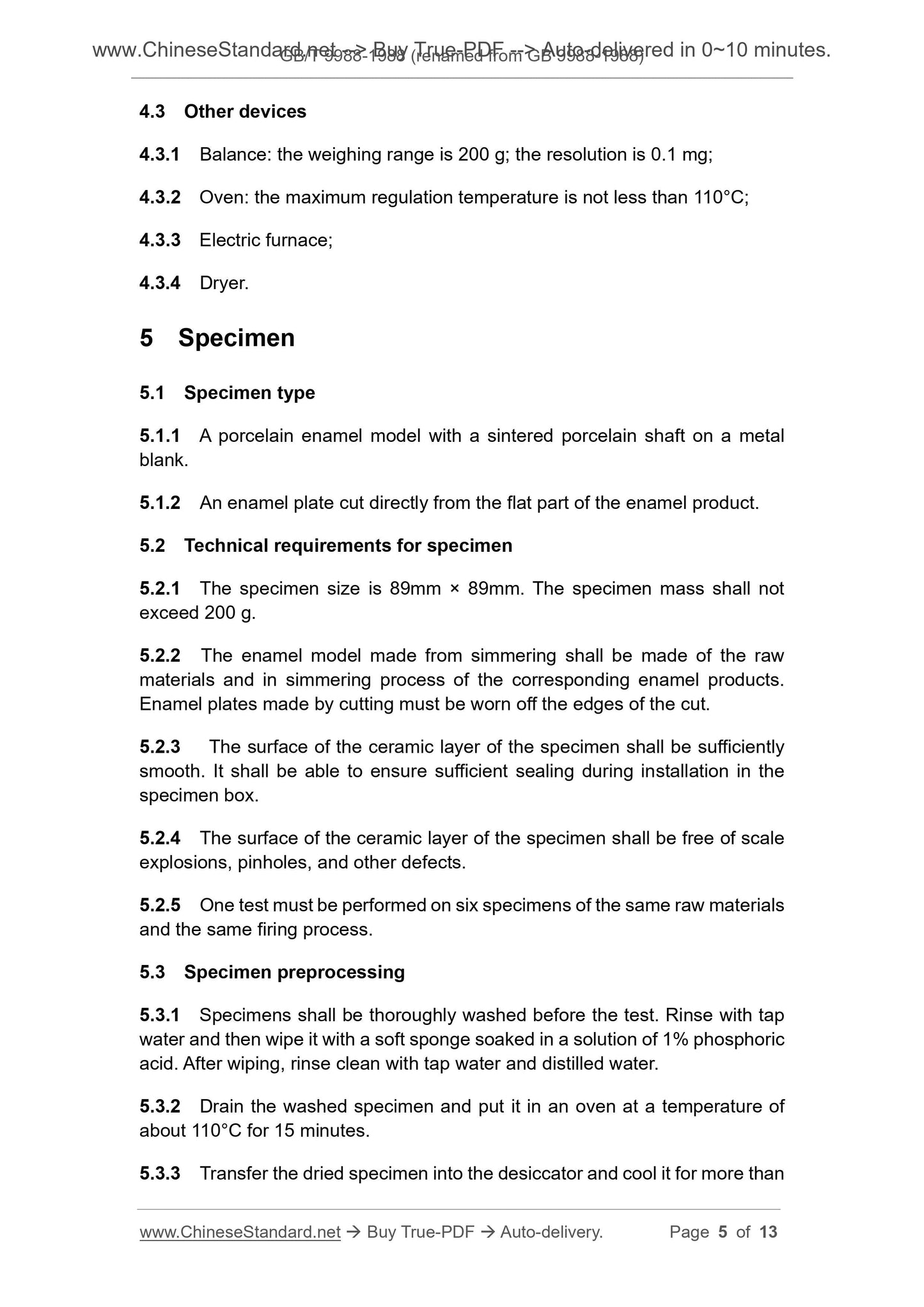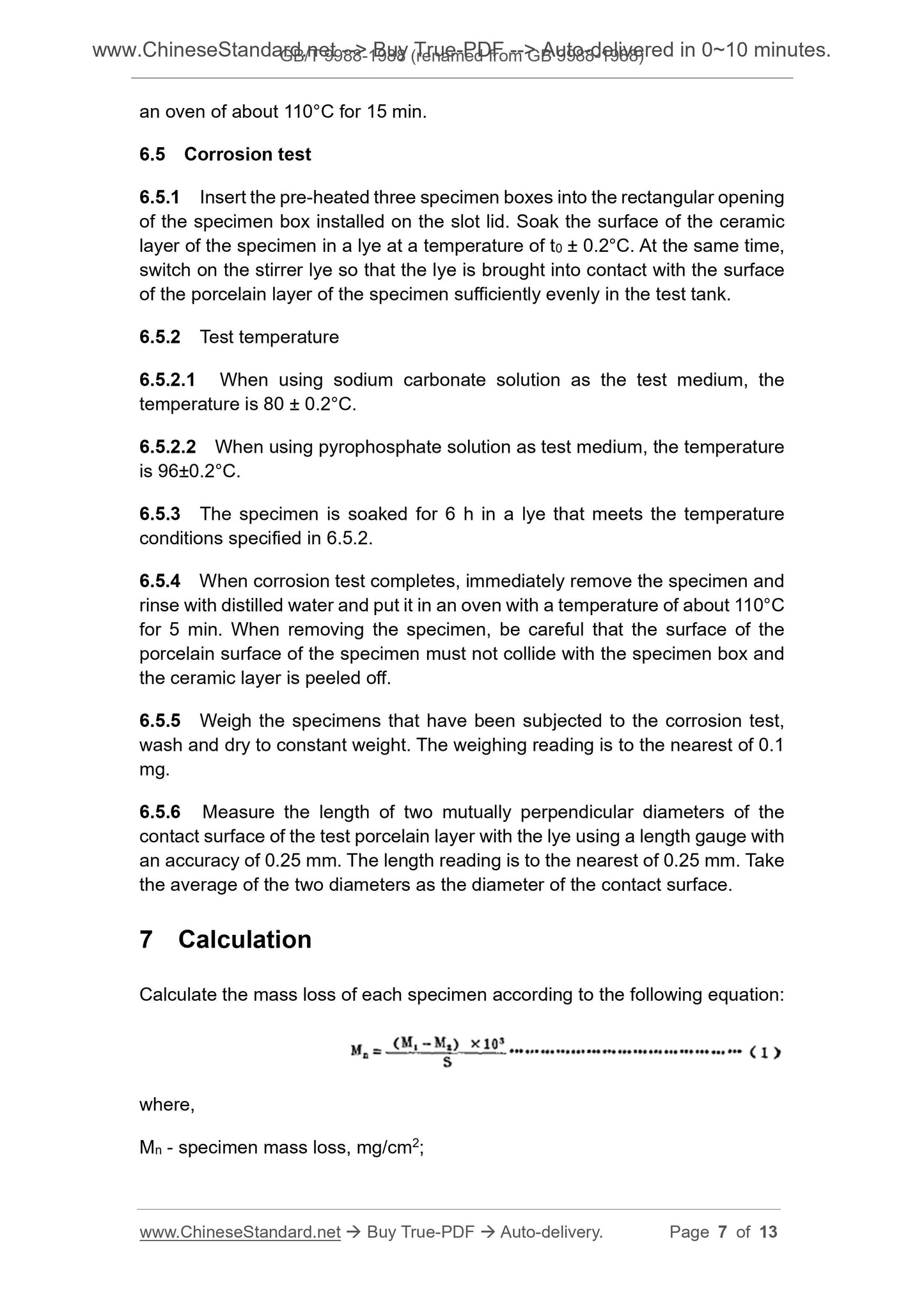1
/
의
5
PayPal, credit cards. Download editable-PDF and invoice in 1 second!
GB/T 9988-1988 English PDF (GBT9988-1988)
GB/T 9988-1988 English PDF (GBT9988-1988)
정가
$95.00 USD
정가
할인가
$95.00 USD
단가
/
단위
배송료는 결제 시 계산됩니다.
픽업 사용 가능 여부를 로드할 수 없습니다.
Delivery: 3 seconds. Download true-PDF + Invoice.
Get QUOTATION in 1-minute: Click GB/T 9988-1988
Historical versions: GB/T 9988-1988
Preview True-PDF (Reload/Scroll if blank)
GB/T 9988-1988: Test method for alkali resistance of porcelain enamels
GB/T 9988-1988 (renamed from GB 9988-1988)
GB
NATIONAL STANDARD OF THE
PEOPLE’S REPUBLIC OF CHINA
Test method for alkali resistance of porcelain enamels
APPROVED ON. JANUARY 27, 1989
IMPLEMENTED ON. JULY 1, 1989
Issued by. Ministry of Light Industry of People's Republic of China
Table of Contents
1 Main content and scope .. 3
2 Test principle overview .. 3
3 Reagents . 3
4 Equipment, instruments and devices . 3
5 Specimen .. 5
6 Test steps .. 6
7 Calculation . 7
8 Data processing . 8
9 Test report . 9
Annex A (Reference) Schematics of main components of enamel alkali
resistance test equipment . 10
Additional Information... 13
Test method for alkali resistance of porcelain enamels
1 Main content and scope
This Standard specifies the test method for the alkali resistance of the enamel
product's surface layer.
This Standard is applicable to the alkali resistance of the daily use and the
quality of the ceramic layer of sanitary enamel products. If sodium hydroxide
solution is used as the test medium, this Standard is also applicable to the
quantitative measurement of the alkali resistance of porcelain surfaces of
enamel glass products.
2 Test principle overview
The method measures the alkali resistance of the enamel material after the
porcelain surface of the enamel specimen is subjected to alkaline solution
erosion at a certain temperature and the quality loss.
3 Reagents
a. NaOH (chemically pure);
b. Pyrophosphate sodium (chemically pure);
c. Three phosphoric acid (chemically pure);
d. Pure distilled water.
4 Equipment, instruments and devices
4.1 Test equipment
4.1.1 Test equipment composition
a. Stainless steel test slot and slot cover;
b. Immersion-style stainless steel heater;
c. Electric stainless-steel mixer;
d. Thermometer;
4.3 Other devices
4.3.1 Balance. the weighing range is 200 g; the resolution is 0.1 mg;
4.3.2 Oven. the maximum regulation temperature is not less than 110°C;
4.3.3 Electric furnace;
4.3.4 Dryer.
5 Specimen
5.1 Specimen type
5.1.1 A porcelain enamel model with a sintered porcelain shaft on a metal
blank.
5.1.2 An enamel plate cut directly from the flat part of the enamel product.
5.2 Technical requirements for specimen
5.2.1 The specimen size is 89mm × 89mm. The specimen mass shall not
exceed 200 g.
5.2.2 The enamel model made from simmering shall be made of the raw
materials and in simmering process of the corresponding enamel products.
Enamel plates made by cutting must be worn off the edges of the cut.
5.2.3 The surface of the ceramic layer of the specimen shall be sufficiently
smooth. It shall be able to ensure sufficient sealing during installation in the
specimen box.
5.2.4 The surface of the ceramic layer of the specimen shall be free of scale
explosions, pinholes, and other defects.
5.2.5 One test must be performed on six specimens of the same raw materials
and the same firing process.
5.3 Specimen preprocessing
5.3.1 Specimens shall be thoroughly washed before the test. Rinse with tap
water and then wipe it with a soft sponge soaked in a solution of 1% phosphoric
acid. After wiping, rinse clean with tap water and distilled water.
5.3.2 Drain the washed specimen and put it in an oven at a temperature of
about 110°C for 15 minutes.
5.3.3 Transfer the dried specimen into the desiccator and cool it for more than
an oven of about 110°C for 15 min.
6.5 Corrosion test
6.5.1 Insert the pre-heated three specimen boxes into the rectangular opening
of the specimen box installed on the slot lid. Soak the surface of the ceramic
layer of the specimen in a lye at a temperature of t0 ± 0.2°C. At the same time,
switch on the stirrer lye so that the lye is brought into contact with the surface
of the porcelain layer of the specimen sufficiently evenly in the test tank.
6.5.2 Test temperature
6.5.2.1 When using sodium carbonate solution as the test medium, the
temperature is 80 ± 0.2°C.
6.5.2.2 When using pyrophosphate solution as test medium, the temperature
is 96±0.2°C.
6.5.3 The specimen is soaked for 6 h in a lye that meets the temperature
conditions specified in 6.5.2.
6.5.4 When corrosion test completes, immediately remove the specimen and
rinse with distilled water and put it in an oven with a temperature of about 110°C
for 5 min. When removing the specimen, be careful that the surface of the
porcelain surface of the specimen must not collide with the specimen box and
the ceramic layer is peeled off.
6.5.5 Weigh the specimens that have been subjected to the corrosion test,
wash and dry to constant weight. The weighing reading is to the nearest of 0.1
mg.
6.5.6 Measure the length of two mutually perpendicular diameters of the
contact surface of the test porcelain layer with the lye using a length gauge with
an accuracy of 0.25 mm. The length reading is to the nearest of 0.25 mm. Take
the average of the two diameters as the diameter of the contact surface.
7 Calculation
Calculate the mass loss of each specimen according to the following equation.
where,
Mn - specimen mass loss, mg/cm2;
Get QUOTATION in 1-minute: Click GB/T 9988-1988
Historical versions: GB/T 9988-1988
Preview True-PDF (Reload/Scroll if blank)
GB/T 9988-1988: Test method for alkali resistance of porcelain enamels
GB/T 9988-1988 (renamed from GB 9988-1988)
GB
NATIONAL STANDARD OF THE
PEOPLE’S REPUBLIC OF CHINA
Test method for alkali resistance of porcelain enamels
APPROVED ON. JANUARY 27, 1989
IMPLEMENTED ON. JULY 1, 1989
Issued by. Ministry of Light Industry of People's Republic of China
Table of Contents
1 Main content and scope .. 3
2 Test principle overview .. 3
3 Reagents . 3
4 Equipment, instruments and devices . 3
5 Specimen .. 5
6 Test steps .. 6
7 Calculation . 7
8 Data processing . 8
9 Test report . 9
Annex A (Reference) Schematics of main components of enamel alkali
resistance test equipment . 10
Additional Information... 13
Test method for alkali resistance of porcelain enamels
1 Main content and scope
This Standard specifies the test method for the alkali resistance of the enamel
product's surface layer.
This Standard is applicable to the alkali resistance of the daily use and the
quality of the ceramic layer of sanitary enamel products. If sodium hydroxide
solution is used as the test medium, this Standard is also applicable to the
quantitative measurement of the alkali resistance of porcelain surfaces of
enamel glass products.
2 Test principle overview
The method measures the alkali resistance of the enamel material after the
porcelain surface of the enamel specimen is subjected to alkaline solution
erosion at a certain temperature and the quality loss.
3 Reagents
a. NaOH (chemically pure);
b. Pyrophosphate sodium (chemically pure);
c. Three phosphoric acid (chemically pure);
d. Pure distilled water.
4 Equipment, instruments and devices
4.1 Test equipment
4.1.1 Test equipment composition
a. Stainless steel test slot and slot cover;
b. Immersion-style stainless steel heater;
c. Electric stainless-steel mixer;
d. Thermometer;
4.3 Other devices
4.3.1 Balance. the weighing range is 200 g; the resolution is 0.1 mg;
4.3.2 Oven. the maximum regulation temperature is not less than 110°C;
4.3.3 Electric furnace;
4.3.4 Dryer.
5 Specimen
5.1 Specimen type
5.1.1 A porcelain enamel model with a sintered porcelain shaft on a metal
blank.
5.1.2 An enamel plate cut directly from the flat part of the enamel product.
5.2 Technical requirements for specimen
5.2.1 The specimen size is 89mm × 89mm. The specimen mass shall not
exceed 200 g.
5.2.2 The enamel model made from simmering shall be made of the raw
materials and in simmering process of the corresponding enamel products.
Enamel plates made by cutting must be worn off the edges of the cut.
5.2.3 The surface of the ceramic layer of the specimen shall be sufficiently
smooth. It shall be able to ensure sufficient sealing during installation in the
specimen box.
5.2.4 The surface of the ceramic layer of the specimen shall be free of scale
explosions, pinholes, and other defects.
5.2.5 One test must be performed on six specimens of the same raw materials
and the same firing process.
5.3 Specimen preprocessing
5.3.1 Specimens shall be thoroughly washed before the test. Rinse with tap
water and then wipe it with a soft sponge soaked in a solution of 1% phosphoric
acid. After wiping, rinse clean with tap water and distilled water.
5.3.2 Drain the washed specimen and put it in an oven at a temperature of
about 110°C for 15 minutes.
5.3.3 Transfer the dried specimen into the desiccator and cool it for more than
an oven of about 110°C for 15 min.
6.5 Corrosion test
6.5.1 Insert the pre-heated three specimen boxes into the rectangular opening
of the specimen box installed on the slot lid. Soak the surface of the ceramic
layer of the specimen in a lye at a temperature of t0 ± 0.2°C. At the same time,
switch on the stirrer lye so that the lye is brought into contact with the surface
of the porcelain layer of the specimen sufficiently evenly in the test tank.
6.5.2 Test temperature
6.5.2.1 When using sodium carbonate solution as the test medium, the
temperature is 80 ± 0.2°C.
6.5.2.2 When using pyrophosphate solution as test medium, the temperature
is 96±0.2°C.
6.5.3 The specimen is soaked for 6 h in a lye that meets the temperature
conditions specified in 6.5.2.
6.5.4 When corrosion test completes, immediately remove the specimen and
rinse with distilled water and put it in an oven with a temperature of about 110°C
for 5 min. When removing the specimen, be careful that the surface of the
porcelain surface of the specimen must not collide with the specimen box and
the ceramic layer is peeled off.
6.5.5 Weigh the specimens that have been subjected to the corrosion test,
wash and dry to constant weight. The weighing reading is to the nearest of 0.1
mg.
6.5.6 Measure the length of two mutually perpendicular diameters of the
contact surface of the test porcelain layer with the lye using a length gauge with
an accuracy of 0.25 mm. The length reading is to the nearest of 0.25 mm. Take
the average of the two diameters as the diameter of the contact surface.
7 Calculation
Calculate the mass loss of each specimen according to the following equation.
where,
Mn - specimen mass loss, mg/cm2;
Share
